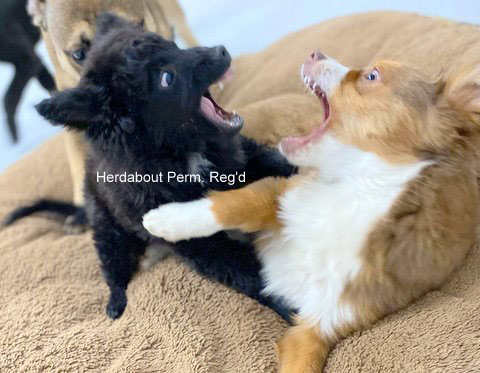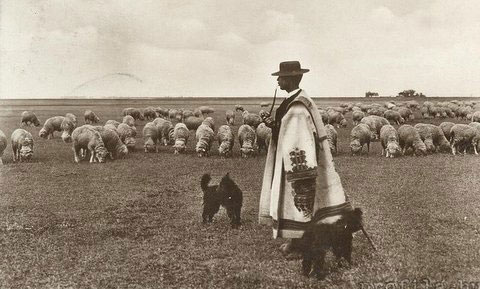About the Mudi

MUDI DESCRIPTION
There is a very good reason for the "high price" of a good Mudi, even when import fees are not an issue. The price for good breeding and good bloodlines are, of course, more expensive than a backyard bred Mudi or a mixed breed Mudi.
Their temperaments are wonderful and rather unique. It is one of the most endearing things about them. The Mudi takes a long time to come into themselves compared to other breeds of dogs, and their socialization window is from 8 weeks of age up to 8 months of age. Mudis do NOT mature mentally very quickly and developing their potential takes a LOT of time and effort. Short cuts are a VERY VERY BAD idea.
Some people seem to think Mudis can be aggressive, but that is not true of the breed in general. There are individuals and exceptions in every breed of dog. Young Mudis tend to be less in control of their emotions, but that does NOT mean they are aggressive. They are expressive, vocal and passionate about how they feel. Mudi puppies play ROUGH, but seldom hurt other dogs in play. Mudis will grow to be more in control of their emotions as they age, however, they may become less tolerant of boiterous, out of control dogs getting up in their face. Proper socialization and training Mudis to respond with attention and focus commands can circumvent any major issue.
Mudis possess loyalty, endurance, intelligence and a strength of character that has been bred into the breed itself for many generations. This is why one must NEVER use a Mudi to produce mix breed dogs. The purity of the Mudi breed, their uniqueness and quality MUST be preserved for future generations. This rare and primitive breed was brought back from near extinction after the second world war by dedicated breeders who still selected only the Mudis with the proper qualities and did not just breed a Mudi simply because it was a Mudi. If we want the Mudi to continue with it's uniqueness we, as breeders and owners, MUST be guardians of the breed and preserve the purity of the Mudi for the future.
In Canada it is a great offence for anyone to purposely use a purebred registered dog to produce mix breed dogs. Members of the Canadian Kennel Club can have their memberships revoked, face hefty fines, and be banned from registering puppies and banned from competing in CKC shows and trials. Even a breeder with an "oops" litter cannot profit from it in any way or they will face such disciplinary action from the Canadian Kennel Club. At Herdabout Perm. Reg'd we do not support ANY mixing of Mudis in breeding, even for "sport mixes".
TRAINING A MUDI
Mudis are love with fur. If the time, patience and investment in training is taken seriously, a lifelong, happy companion will be the result. Mudis are one of the most lovable and entertaining creatures on four feet.
Socialization for a young Mudi is way more important than obedience training. Mudis are super smart so training can occur at any point, but socialization is a MUST. Keeping a young Mudi isolated from other breeds of dogs, keeping them from meeting people, keeping them from visiting places and experiencing different sights and sounds (in a positive way) can result in a very depressed and anxious Mudis who may be unable to handle such exposures later in life. Mudis thrive best with lots of outdoor POSITIVE experiences, especially between 8 weeks and 8 months of age.
Modern "Shaping" methods and training practices are usually inappropriate for the Mudi. Even using a clicker to mark correct behavior is NOT as good as simply saying "YES". Mudis can be "one event learners", and they do not need a million building blocks to get trained. Positive reinforcement using both "Classical Conditioning" and "Operant training" usually works best for success in training a Mudi. It is important for new Mudi owners to find an experienced and accomplished trainer who knows the breed, or at least something similar in the Herding Group (Puli, Australian Cattledog, Maliniois, etc.). Most "Family Pet" trainers, who have not competed with any of their own dogs in Obedience trials, etc.) are not experienced enough to work with a Mudi. Punishment training does not work with Mudis, one can easily "break" a Mudi from harsh punishments.
HEIGHT & WEIGHT
A Mudi usually weighs 18 to 30 pounds (8.2 to 13.2 kg) and stand 15 to 19 inches (38 to 48 cm) high at the withers. The standard colours are Black, Brown, Brown Merle, White, Fawn, Ash, Ash Merle, and Blue Merle (the colour "Black Merle" is the term the AKC and the USA uses to register what the rest of the world describes as a Blue Merle).
COAT AND TAIL
The coat is medium wavy or curly, with short hair on the face and legs. The Mudi is easy to groom. Their coat is basically self cleaning
(dirt doesn't stick to their hair). They have a dense undercoat (not floofy). An occasional combing and brushing to remove dead hair is all it needs. This breed is typically a low shedder. The fur texture is similar to human hair. Mudis can be bathed and towel or drip dried. If one blow dries a Mudi it can straighten out the curls and make the dog look like a Pomeranian with a "bad perm".
Mudis may be born with various lengths of tails from short (natural bobtail) to long, and all are acceptable by the breed standard. Docking is not recommended and is not done on a Mudi. At Herdabout Perm. Reg'd we only breed long tail Mudis.
A MUDI'S PURPOSE
The Mudi is a versatile farm dog that can hunt, exterminate rodents, and act as a capable herding dog and guardian. They are great for alerting and protecting their home and family. The have a variety of barks, from high pitched bark to low and grumbly. The Mudis bark like any other herding dog, to alert their owners and in play. Mudis do not bark without a reason, however their bark can be quite loud for such a small dog. The Mudi is a clever, keen, active, dog who will become very, very attached to its owner and family. They learn quick both good things and bad things. The Mudi may be aloof with strangers and early socialization is strongly recommended.
The Mudi is a very active breed and needs daily exercise, but they will adjust to your lifestyle. They love to play and will excel in all kinds of dog sports, swimming, freestyle and Frisbee. The Mudi can live in an apartment if it is sufficiently exercised as they do need space to run and play. They are moderately active indoors and will do best with at least a large yard.
The Mudi is a fairly healthy breed, as it has not been over bred due to popularity and remains quite primative. Average life expectancy of a Mudi is 12 –15 years, although some have lived to 18 years of age.
**See our Mudi Health page for more specific information on health.
CANADIAN KENNEL CLUB
In 2002 the Mudi was approved by the board and added to the Canadian Kennel Club (CKC) Miscellaneous Class.
At this time the Mudi was shown in the Miscellaneous Class against other Miscellaneous Breeds. (Kelpie, JRT, Border Collies etc.) They could not earn a Canadian Kennel Club conformation championship. The Mudi could be show in any FCI standard shows for championships like the Rare Breed Club and the All Breed International Club.
In 2003 the Mudi was accepted by the CKC (Canadian Kennel Club) into the Miscellaneous Group and the Mudi was added to the Herding Group 7.
Miscellaneous Listed Breeds are authorized to participate in all CKC events in accordance with the rules and regulations governing those events. This includes conformation championships and performance sport events.
In November 2016 the Mudi breed was voted into full recognition by the Canadian Kennel Club referendum, pending approval by the Minister of Agriculture and the MOA accepted the Rules Of Eligibility.
On March 08, 2021 the Mudi was finally moved into Full CKC recognition and the issuing of regular CKC registration numbers, registration certificates and certified pedigrees were mandated.
The Canadian Kennel Club is the only official club in Canada representing the Mudi. The CKC is held to the FCI breed standard as there is no official "breed club" in Canada overseeing the Mudi except the Canadian Kennel Club.
MUDI HISTORY
The Breed is Called Mudi (Pronounced moody). More then one Mudi spoken or written in English is Mudis. The plural for Mudi in the written and spoken Hungarian Language is Mudik.
The first breed description was found in the 18 century, where an excellent and generally black, Mudi-like sheep-dog was described.
There are 3 small Hungarian Sheepdogs, the Puli, Pumi and Mudi. These three breeds were separated by coat type in the 1930s. As late as the 1980's it still was possible for a Mudi to have Puli in the litter or Puli to have Mudi in the litter.
The breeding of Mudis was started by Dezső Fényes, the director of the Museum of Balassagyarmat, in the 1930's.
In March 1936 the Mudi was accepted as separate breed and at this time the first breed standard was accepted.
The Official recognition and Breed Standard of the Mudi was added to the list of purebred dogs by the Federation Cynologique Internationale (FCI).
The Black Mudi closely resembles the Croation Sheepdog. Early breed standards had the Mudi and the CS accepted colours as Black or black/white (pibald) in 1963 when the breed was accepted into the FCI acceptable colours were Black, White, Brown, Ash.
The Fawn and Blue Merle (Cifra) were added in 2003.
In 2020 the colours Ash Merle and Brown Merle were also added as accepted colours by the FCI and Canadian Kennel Club.
While the Mudi is a herding and all purpose farmdog, the Mudi today is bred for and all around farm dog, herding, companionship, dog sports and conformation showing.

|



